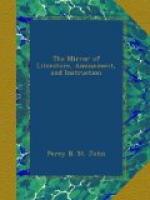* * * * *
FINE ARTS
HOGARTH’S MARRIAGE-A-LA-MODE.
Hogarth’s admirable series of pictures, entitled Marriage-a-la-mode, were at first slightly treated by the public, at which the artist was greatly incensed. Being in want of money, he was at length obliged to dispose of them to Mr. Lane, of Hillington, for one hundred and twenty guineas. The pictures being in good frames, which cost Hogarth four guineas a piece, his remuneration for painting this valuable series was but a few shillings more than one hundred pounds. On the demise of Mr. Lane, they became the property of his nephew, Colonel Cawthorn, who very highly valued them. In the year 1797 they were sold by auction, at Christie’s, Pall Mall, for the sum of one thousand guineas; the liberal purchaser being the late Mr. Angerstein. They now belong to government, and are the most attractive objects in the National Gallery.
* * * * *
HAMPTON COURT PALACE.
The gardens and park, which are three miles in circumference, appear to me to be above all competition. As you enter, you are struck with the majestic beauty of the trees, and the fine gravel walks. As you advance, the fountains and statues demand your admiration; particularly the famous Gladiator, which was brought from Rome. While in the gardens, the statues of Flora, Ceres, Pomona, and Diana, placed on the west front of the building, are seen to much advantage.
The magnificent palace was originally built by Cardinal Wolsey, and consists of three principal quadrangles. Here Cromwell resided, and it was the favourite residence of William and Mary. It is chiefly built of brick, and is very capacious, more so than any other royal palace in the British empire. Arriving at the great entrance, you almost seem as if you were about to enter a fairy castle. The floor of the hall is laid out in beautiful square slabs of marble, and a staircase of the same material leads you to the upper apartments, which contain pictures and numerous curiosities.
Among the fine paintings, I shall notice a few, which appear to me as being perfect master-pieces. But I must first take the liberty of saying a word or two about the gentleman who conducts you through the rooms to explain the several pictures. When I had the pleasure of being with him, his hair was powdered, and he carried a silver-headed cane. He hurried me through the rooms, filling my ears with such gibberish as this:—“That ere picture, sir, up there, was painted, five hundred years ago, for William the Conqueror, by Wandyke."[4] This is no mean blunder in chronology!
[4] Sir Antony Vandyke, who died about the year 1640.
There is a fine portrait of William the Third on horseback, of the size of life, by Sir Godfrey Kneller; the horse is painted in a side view, and has a good effect. There are eight fine female portraits of distinguished personages, by the same hand, in the highest state of preservation.




